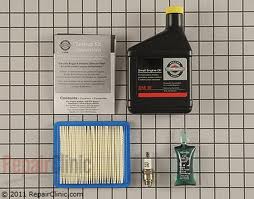Winterize your small engine for a easy Spring start.
If you live in Canada, chances are you wont be using your lawn mower or hedge trimmer for at least 5 months.
Clean-up
If you have a pressure washer feel free to use it but, BE CAREFUL, dont spray it into sensitive engine parts or componets. Take care that you do not force dirt and water into bearings that were not designed to withstand that kind of pressure. The high pressure spray will also wash away any lubricant that it hits. After a good cleaning it would not hurt to oil the steel metal.
Inspect
Next step is to inspect the deck, deck belts, hangers, and blades. If anything is broken or worn, plan to replace it during this winters downtime. If you have the deck off or tractor jacked up, remove the blades and have them sharpened. You can get the blades off by blocking the blade with a piece of wood and unscrewing the blade bolt or nut. Wearing gloves is a good idea especially when re-installing the sharpened or new blades. Its a good idea to replace deck belts that have any signs of wear. That way your guaranteed to get through the next cutting season without any downtime for a belt that you knew would not make it.
Lube
If you have removed the deck, now is a good time to lubed the tractor. Use your owners manual. Most owners manuals will point out where, and what kind of lube should be applied.
Oil change
Check the oil level first and examine it, if it is clear and not grimy you dont have to bother it is a little tired looking, we recommend changing it.
Gas Stabilizer or drain the carb
| Gasoline is very dangerous. Work only in a well ventilated area, away from any source of heat or open flame |
Start by changing the fuel filter. Clamp off the fuel line between the tank and the fuel filter. Remove the filter by loosing the clamps that hold it and pulling it out of the hose. Be careful to catch any gasoline that may spill. Always replace the hose that is between the filter and the carburetor. Notice that the filter usually has barbs on it. These barbs tear the inside of the hose when the filter is removed. A piece of hose could enter the carb and cause real problems.
Remove the air filter and precleaner. Clean or replace them as necessary. Reinstall the Air Cleaner.
Next, lets prepare the gasoline itself. I have often read that gasoline is only good for 90 days. There are 2 problems with this. The first one is its 90 days from date of manufacture not from when you bought it. The second is that gasoline is volatile in air, meaning that it evaporates quickly. Gasoline should be stored no more than 30 days without treatment and should be stored in an environmentally friendly container. But what about the gasoline in you tank. The same 2 problems occur there also. So we must prepare the fuel system to sit out the winter without damage. There are 2 schools of thought here. One is to drain all the gas leaving the fuel system dry for the winter. The problem with this is that water can collect in the system because of condensation. The water will cause as much or more damage then the gas will. But leaving the fuel system full will cause just as much trouble due to stale gas and the solids that collect at the point of evaporation. The latest thinking for storage is to fill the tank with gas that has been treated with stabilizer. The stabilizer keeps the gas fresh and helps prevent the build up of deposits. The full tank keeps the condensation from happening. Note that after you fill the tank with stabilized fuel you must run the engine for about 10 minutes so that the treated fuel enters the carb. We like to blend both methods and add fuel stabilizer to fuel for last few weeks of equipment and operate on it and then drain completely (it has worked for us so we like the blended approach). Remember anything is better than leaving untreated fuel in the gas tank.
Spark Plug
Remove the spark plug. Put a teaspoon of engine oil into the spark plug hole. Replace the spark plug with a new one(s). Crank the engine over a few times to spread the oil inside the cylinder(s). And if its possible on your engine turn the engine over by hand until you feel the compression stroke. This closes the valves and prevents moisture from getting into the engine.
Battery
The last step. Remove the battery from the unit and store it in a warm spot NEVER STORE ON THE GROUND. If you have a battery charger it would be good to charge the battery before storing it.






